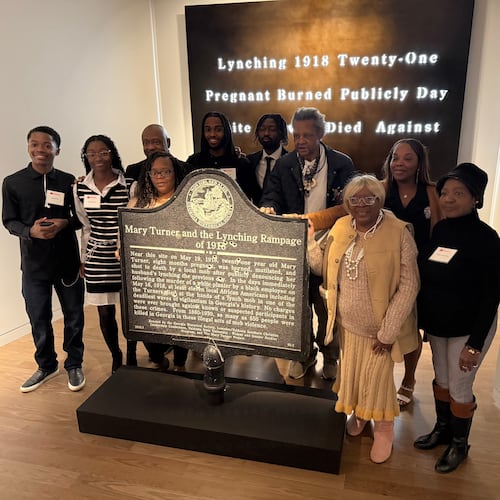ATHENS —Years ago, quilting friends Sandy Benjamin-Hannibal and Peggy Hartwell came to Gospel Pilgrim Cemetery on Fourth Street, looking for the grave of Harriet Powers, an African American quilter buried in 1910. Because the handmade marker they had found during another previous visit was gone, they were relying on memories to guide them through an overgrown tangle of vegetation.
The lack of permanent commemoration bothered the two women, and “I thought something’s gone to be done,” says Benjamin-Hannibal. She and Hartwell reached out to historian, curator and quilter Carolyn Mazloomi, founder of the Women of Color Quilting Network. The members responded, raising money for a granite headstone for the graves of Harriet and her husband Armstead.
Credit: Nell Carroll special to Journal-Constitution
Credit: Nell Carroll special to Journal-Constitution
Born a slave in 1837 on a plantation in neighboring Madison County, Harriet Powers married her husband in 1855, moved to Clarke County and started a family, eventually having nine children. Three of them survived into adulthood.
On Saturday, quilters from across the country, and non-quilters from Athens, gathered in the cemetery for a “recommittal and dedication ceremony” to celebrate and honor the two Powers with a new granite headstone. The event’s organizers said they were “shocked” at the number of people — about 100 — who came to the ceremony. Mazloomi says she was expecting only ten people.
Credit: Nell Carroll special to Journal-Constitution
Credit: Nell Carroll special to Journal-Constitution
Two attendants were Lynette Warren and Marikay Waldvogel who came from Marietta and Tennessee. Gloria Larkin and Peggy Martin came from the Brown Sugar Stitchers in Dekalb County. Others came from Chicago and Houston.
Journalists and photographers from different quilting publications were also present, snapping photos and talking to quilters. The ceremony included a rendition of “We’re Climbing Jacob’s Ladder,” scripture readings, prayers and a litany honoring “ALL Black women for the contributions they have made and continue to make.”
Washington, D.C., resident Alyse Minter, Harriet and Armstead Powers’ great-great-great granddaughter, spoke to the crowd about what she had learned from researching her ancestors: that she comes from a long line of strong women and that her Powers ancestors loved each other deeply. Her mother, Linda Minter, says she didn’t know anything about her family history until Alyse started doing genealogical research a few years ago. She said the day’s events left her feeling overwhelmed.
Scholars consider Powers to be the most important American artist in the story quilt tradition though only two of her creations survive: the Bible Quilt is in the Smithsonian Museum and the Story Quilt is in the Boston Museum of Fine Arts. Many quilters consider the Bible Quilt to be the most significant American quilt.
Credit: Nell Carroll special to Journal-Constitution
Credit: Nell Carroll special to Journal-Constitution
“Powers is one of the most important women artists, ever,” says Jennifer Swope, the David and Roberta Logie Curator of Textiles at the Boston Museum of Fine Arts. “What she’s presenting is a cosmology.” She believes the two quilts are the artist’s masterworks. Powers herself called the Bible Quilt “the darling of my brain.”
Featuring both hand and machine stitches, it’s composed of 11 different panels, each illustrating a story from the Old or the New Testament, including the creation story, Cain murdering Abel, Jacob’s dream, Satan amidst seven stars, the Crucifixion and the Holy Family.
Historian Kyra Hicks of Arlington, Virginia, is the author of “This I Accomplish: Harriet Powers Bible Quilts and Other Pieces.” She says Powers made the Bible Quilt in 1886 and entered it in a county fair in Athens. Jennie Smith, an art teacher at the Lucy Cobb Institute, initially wanted to buy the quilt, but Powers wouldn’t sell it until her husband and she fell on hard times. Before releasing it, she told Smith what each of the panels meant, and Smith wrote down her explanations.
Smith also allowed Powers to come visit the quilt, which was later displayed at the Atlanta Cotton Exposition in 1895. The executor of Smith’s estate kept the quilt for 20 years before giving it to the Smithsonian. “He apparently fell in love with it,” says Hicks.
After seeing the Bible Quilt at the exposition, some faculty women from Atlanta University were so taken with it that they commissioned Powers’ Story Quilt as a gift for a trustee, the Reverend Charles Cuthbert Hall, president of New York’s Union Seminary. This work has fifteen pictorial panels, which tell both Bible stories “that illustrate her beliefs with stories that were told to her,” says Mazloomi.
Credit: Nell Carroll special to Journal-Constitution
Credit: Nell Carroll special to Journal-Constitution
Powers documents with fabric an eclipse in 1780, an 1833 meteorite shower and a cold day in 1895, as well as Jonah being swallowed by a whale, Christ being baptized with the spirit landing like a dove and Mary and Martha at the cross of Jesus.
“It’s difficult to find a textile piece made by a named enslaved person, which is one reason Harriet’s quilts are so revered, and to have documentation,” says Hicks. “It’s just phenomenal that she is still able to share her faith more than 100 years after she passed away. Phenomenal.”
About the Author
Keep Reading
The Latest
Featured

